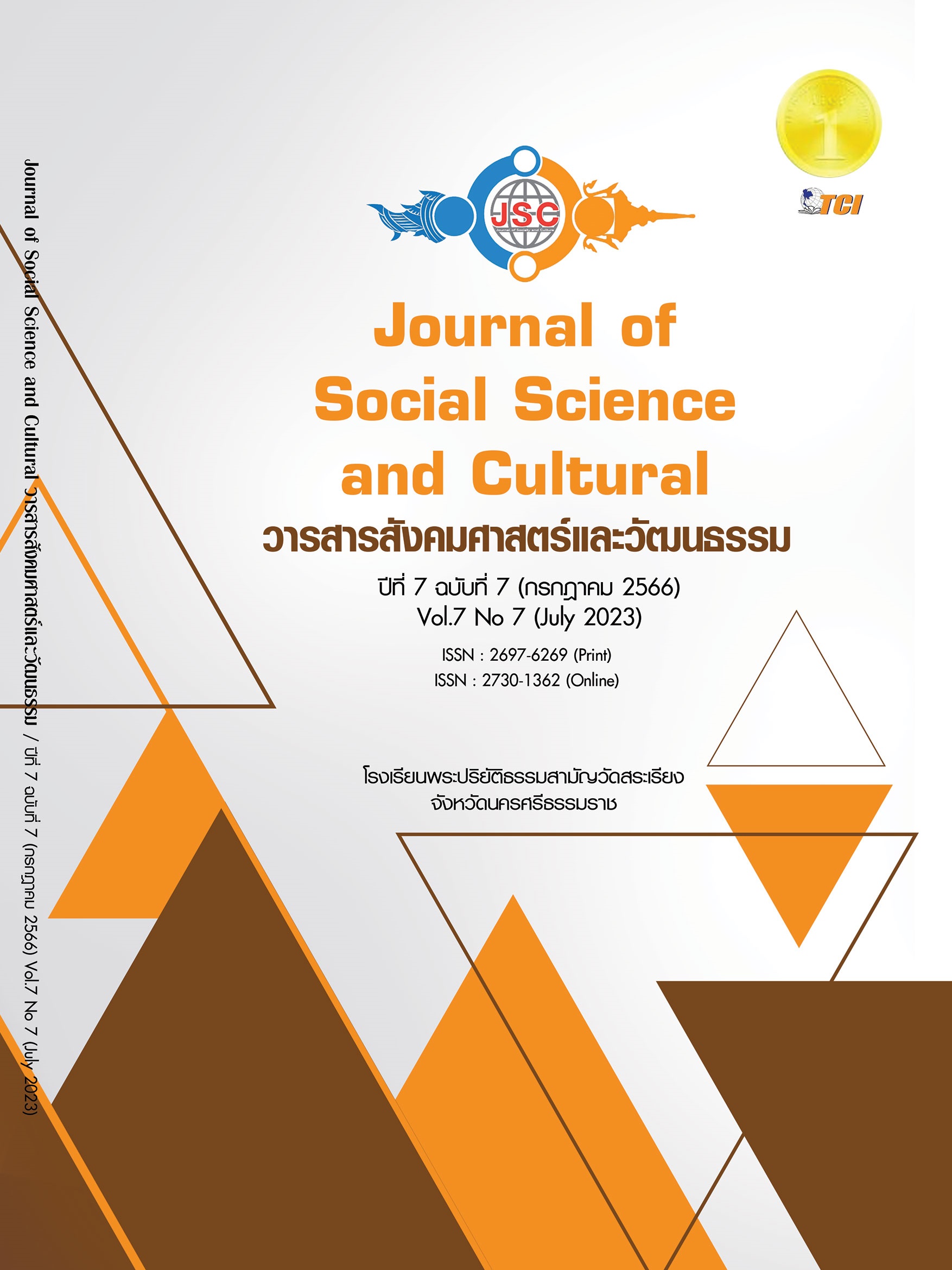THE INFLUENCE OF AMBIDEXTROUS OF TOP MANAGEMENT, TECHNOLOGICAL INNOVATION AND MARKET COMPETITION PRESSURES ON RISK ASSESSMENT INFORMATION SYSTEM OF EXPORTING ENTREPRENEURS IN THAILAND
Main Article Content
Abstract
The objective of the research was to examine: 1) the influence of ambidextrous of top management, technological innovation, and market competition pressures on the risk assessment information system of exporting entrepreneurs in Thailand and 2) the influence of risk assessment information system on the competitive advantage of exporting entrepreneurs in Thailand. This study was quantitative research using a questionnaire to collect data from 225 exporting entrepreneurs listed in the database of the Ministry of Commerce by purposive sampling. The structural equation modeling (SEM) techniques were used to test the hypothesis. The results found that ambidextrous of top management, technological innovation, and market competition pressures significantly positively influence the risk assessment information system of exporting entrepreneurs in Thailand, which shows that ambidextrous of top management, technological innovation, and market competition pressures are an essential factor leading to enabling risk assessment information systems as the management accounting practice of exporting entrepreneurs in Thailand. In addition, the risk assessment information system also influences the competitive advantage of exporting entrepreneurs in Thailand. Building a competitive advantage by enabling risk assessment information systems in the organization requires a focus on ambidextrous management, consideration of the quality of available technological innovations, and market competition pressure. Moreover, this study contributes to further expanding the literature on advanced management accounting techniques in the digital era and future research directions.
Article Details
References
สำนักงานปลัดกระทรวงพาณิชย์. (2564). ผู้ส่งออก-นำเข้า. เรียกใช้เมื่อ 26 ตุลาคม 2564 จาก http://www2.ops3. moc.go.th/ie/Default.aspx
Ahmad, K. & Zabri, S. M. (2015). Factors explaining the use of management accounting practices in Malaysian medium-sized firms. Journal of Small Business and Enterprise Development, 22(4), 762–781.
Al_Bdairi, A. S. J. et al. . (2020). Using Modern Cost Techniques in Achieving Competitive Advantage. An Empirical Study in Iraqi Industrial Companies, 13(6), 1371–1388.
Alamri, A. M. (2019). Association between strategic management accounting facets and organizational performance. Baltic Journal of Management, 14(2), 212–234.
AlQershi, N. (2019). Innovation Capabilities as a Source of Inspiration: Towards a Sustainable Competitive Advantage in Yemen Manufacturing Industry. International Journal of Knowledge Management and Practices, 7(1), 1–6.
Awa, H. O. et al. (2016). Using T-O-E theoretical framework to study the adoption of ERP solution. Cogent Business and Management, 3(1), 1–23.
Bollen, K. A. (1989). A New Incremental Fit Index for General Structural Equation Models. Sociological Methods & Research, 17(3), 303–316.
Byrne, B. M. (2001). Structural Equation Modeling With AMOS, EQS, and LISREL: Comparative Approaches to Testing for the Factorial Validity of a Measuring Instrument. International Journal of Testing, 1(1), 55–86.
Du, J. & Chen, Z. (2018). Applying Organizational Ambidexterity in strategic management under a “VUCA” environment: Evidence from high tech companies in China. International Journal of Innovation Studies, 2(1), 42–52.
Farrar, M. (2019). Re-inventing finance for a digital world: The future of finance. Durham, North Carolina, U.S.A.: AICPA&CIMA.
Hair, J. F. et al. (2018). Multivariate Data Analysis (8th ed.). Cengage Learning, EMEA: Hampshire.
Hu, L. T. & Bentler, P. M. (1999). Cutoff criteria for fit indexes in covariance structure analysis: Conventional criteria versus new alternatives. Structural Equation Modeling, 6(1), 1–55.
Kline, R. B. (1998). Principles and Practice of Structural Equation Modeling. New York: Guilford.
Kruskopf, S. et al. (2020). Digital accounting and the human factor: Theory and practice. ACRN Journal of Finance and Risk Perspectives, 9(1), 78–89.
Möller, K. et al. (2020). Digitalization in management accounting and control: an editorial. Journal of Management Control, 31(1–2), 1–8.
Ogungbade, O. I. et al. (2017). Antecedents To Choice of Management Accounting Practices Among Manufacturing Companies in Nigeria. International Journal of Economics, Commerce and Management, 5(10), 46–66.
Otley, D. (2016). The contingency theory of management accounting and control: 1980-2014. Management Accounting Research, 31(June 2016), 45–62.
Pavlatos, O., & Kostakis, X. (2018). The impact of top management team characteristics and historical financial performance on strategic management accounting. Journal of Accounting and Organizational Change, 14(4), 455–472.
Petera, P. & Šoljaková, L. (2020). Use of strategic management accounting techniques by companies in the Czech Republic. Economic Research-Ekonomska Istrazivanja, 33(1), 46–67.
Piórkowska, K. (2016). Creativity, ambidextrous leadership and innovative performance: a multi-level conceptual framework. In In Proceedings of The 27th International Business Information Management Association Conference. International Business Information Management Association (IBIMA).
Saeidi, P. et al. (2021). The influence of enterprise risk management on firm performance with the moderating effect of intellectual capital dimensions. Economic Research-Ekonomska Istrazivanja, 34(1), 122–151.
Salkind, N. J. (2012). Exploring Resrearch (8th Edition). In Pearson Education: Inc.
Severgnini, E. et al. (2019). Risk and organizational ambidexterity: A meta-synthesis of a case study and a framework. Brazilian Business Review, 16(5), 470–499.
Simmonds, K. (1981). Strategic management accounting. Management Accounting (UK), 59(4), 26–29.
Steiger, J. H. (2000). Point estimation, hypothesis testing, and interval estimation using the RMSEA: Some comments and a reply to hayduk and glaser. Structural Equation Modeling, 7(2), 149–162.
Sun, Y. et al. (2020). Measuring and integrating risk management into green innovation practices for green manufacturing under the global value Chain. Sustainability (Switzerland), 12(2), 545–578.
Teymouri, M. & Ashoori, M. (2011). The impact of information technology on risk management. Procedia Computer Science, 3(2011), 1602–1608.
Uyar, M. (2018). Evaluation of the Relationship Between Management Accounting System , Risk Management and Company Performance By Using Structural Equation Model. Journal of Business Research Turk, 10/3(2018), 144–147.
Wang, Z. et al. (2020). Risk Analysis of Enterprise Management Accounting Based on Big Data Association Rule Algorithm. Journal of Physics: Conference Series, 1631(2020), 012098.
Zainuddin, Z. N., & Sulaiman, S. (2016). Challenges Faced by Management Accountants in the 21st Century. Procedia Economics and Finance, 37(16), 466–470.


